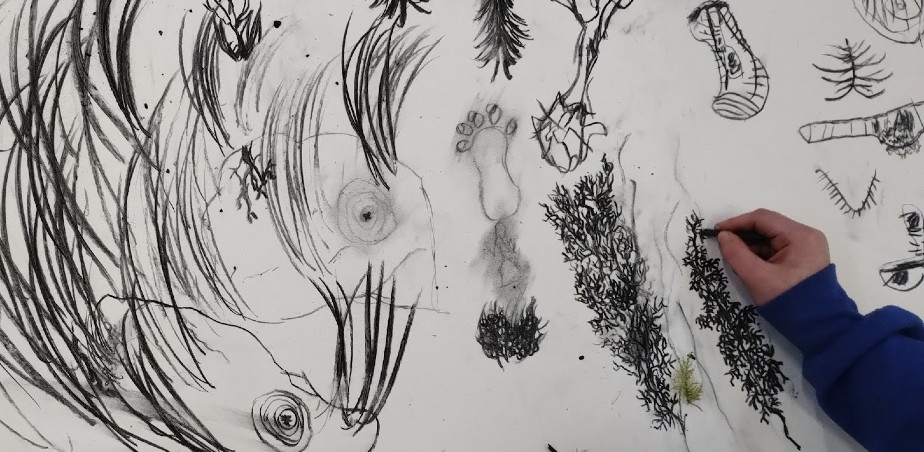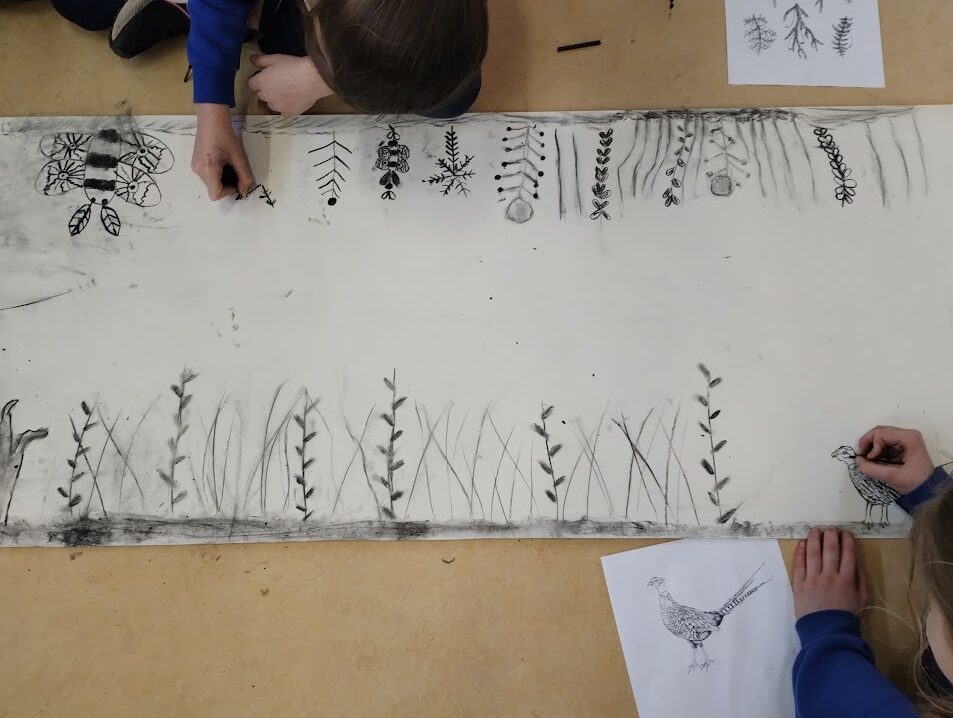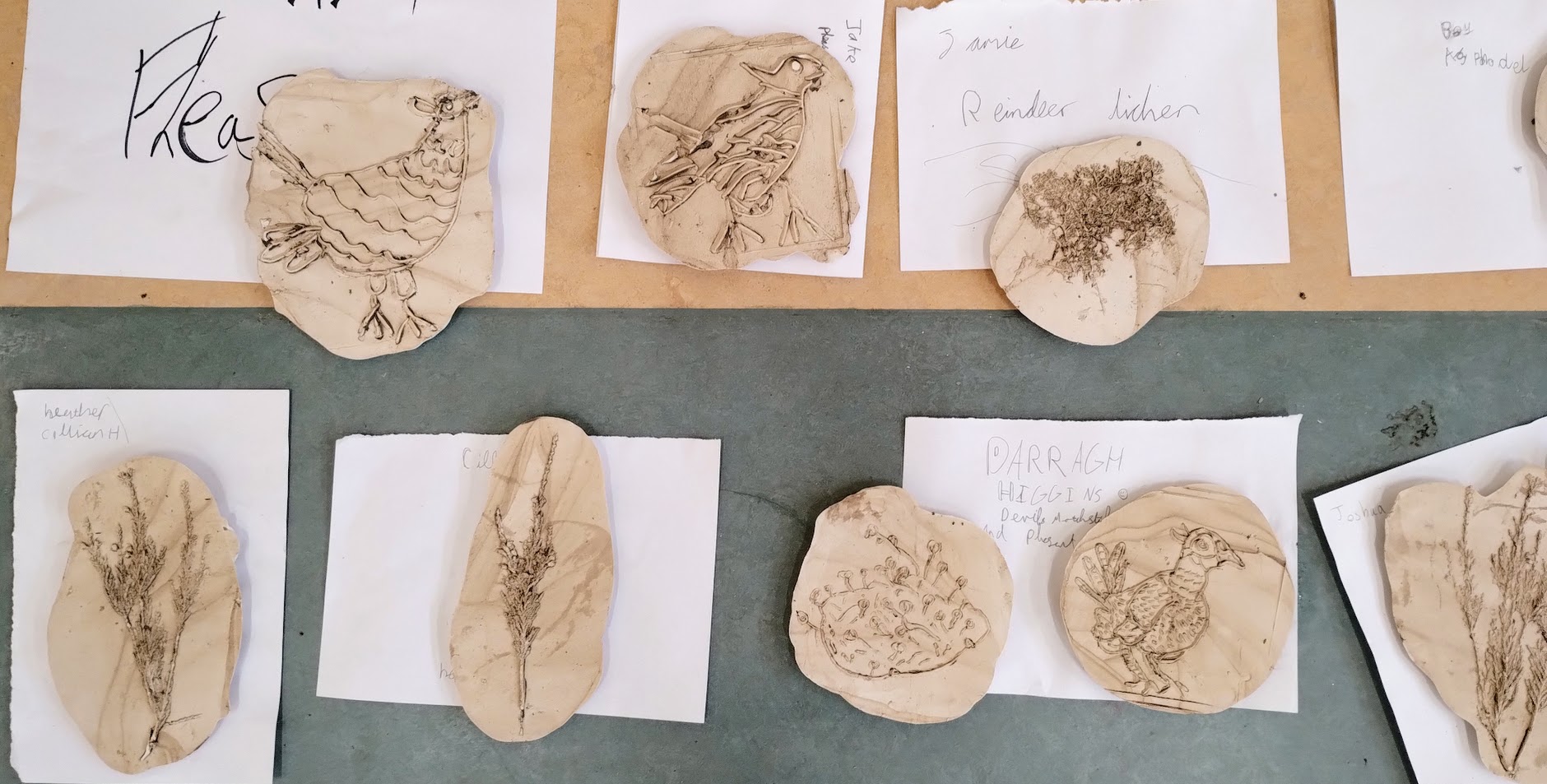Blag 2 – An Dr. Jo Lewis, Ealaíontóir & Faighteoir na Dámhachtana Sparánachta do Dhaoine Óga, Leanaí agus Oideachas ón gComhairle Ealaíon

Grianghraif de Scoil Náisiúnta na Gaobhaí Co. Shligigh. Tionscadal portaigh. Idir plandaí agus fána a shainaithint, chomh fada le hiad a tharraingt agus teilgean plástair a dhéanamh dóibh.

Ghnóthaigh Jo Lewis céim Bhaitsiléara Ealaíon sa Mhínealaín in Coventry agus céim Mháistreachta i Mínealaín sa Dealbhóireacht ó Scoil Ealaíne Birmingham. Bhí stiúideo aici i stiúideonna SPACE Londan ar feadh roinnt blianta, áit ar oibrigh sí agus ar chuir sí saothair ar taispeáint agus í ag reáchtáil na bialainne veigeatóra 100 suíochán, Heather’s, san am céanna, in éineacht lena páirtí.
In 2002, d’aistrigh Jo ó Londain go Co. Liatroma lena páirtí agus lena gclann óg gur chóirigh siad seanteachín cloiche, chun ‘saol maith’ a bheith acu.
Le linn an ama seo, ghnóthaigh sí PhD ag SOAS (Scoil na Staidéar Oirthearach agus Afracach) as a cuid taighde ar Ealaíontóirí Mná na Botsuáine. Tá an tráchtas s’aici anois faoi choimeád Leabharlann na Breataine.
D’oibrigh Jo ar an tionscnamh BLAST (Ealaín Bheo a Thabhairt chuig Daltaí agus Múinteoirí) agus theagasc sí i scoileanna ar fud chontae Shligigh. Le déanaí, le haghaidh na mionchónaitheachtaí seo i scoileanna, dhírigh Jo ar na daltaí a thabhairt amach faoin spéir chun ealaín a dhéanamh agus inspioráid a fháil. D’úsáid sí tírdhreach áitiúil mar chúlra chun tumadh isteach in éiceolaíocht na háite tríd an ealaín.
In 2023, bhronn Comhairle Ealaíon na hÉireann sparánacht ar Jo chun rud beag taighde a dhéanamh ar an gcomhéadan idir an ealaín agus an éiceolaíocht san oideachas scoile mar bhealach chun spéis a mhúscailt i measc páistí i leith a dtimpeallachta.
Ealaín a úsáid chun an Éiceolaíocht a fhiosrú agus le foghlaim fúithi
Sainmhíniú ar Chomhéadan: dromchla a chruthaíonn teorainn choiteann de dhá chorp, dhá spás, nó dhá chéim.
Le himeacht ama, tá an comhéadan idir ealaín agus eolaíocht fiosraithe ag ealaíontóirí go leor; is é an spás sin ina dtagann an dá dhisciplín le chéile agus ina mbíonn an spás mar bhonn eolais ag smaointeoireacht an chinn eile. Smaoinigh ar Leonardo da Vinci (innealtóireacht agus ealaín) sna 1500ídí chomh fada le Grace Weir (fisic agus ealaín) in 2024.
Is idirphlé spreagúil é a chuireann raon bealaí ar fáil isteach in ábhar eolaíochta ar leith nó saothar ealaíne. Ceanglaíonn sé an inchinn anailíseach lenár mothúcháin. Trí shamhlú, is féidir an rud cruthaitheach a thabhairt isteach sa rud eolaíochta agus trí íomhánna is féidir an t-eolaí a thabhairt isteach chuig mothúcháin. Tráth a bhfuil méadú ag teacht ar scaradh ón dúlra tá sé tábhachtach bealaí a aimsiú chun nascadh arís agus tuiscint níos fearr a fháil ar ár dtimpeallacht. Trí fhíricí faoin éiceolaíocht a fhiosrú tríd an ealaín, is féidir tuiscint agus nasc níos doimhne a dhéanamh. Is é seo a bhfuil súil agam a thabhairt chuig mo cheardlanna scoile, ba mhaith liom go bhfoghlaimeodh na leanaí faoin éiceolaíocht timpeall orthu trí phróisis déanta ealaíne atá cruthaitheach spraíúil.
Is cur chuige iontach é an comhéadan seo a úsáid idir ealaín agus eolaíocht do mhúinteoirí atá ag múineadh sa bhunscoil atá faoi bhrú an oiread sin ábhar a sheachadadh laistigh dá bpleananna ranga seachtainiúla. Trí ábhar amháin a úsáid, an ealaín, le ciall a bhaint as na heolaíochtaí, is féidir ansin roinnt ábhar a chlúdach ag an am céanna.
Is breá le leanaí a bheith cruthaitheach - is é an bealach a dhéanfaidh an chuid is mó díobh ceangal leis an domhan. Má thugtar an eolaíocht isteach i rang ealaíne, cabhróidh sé le páistí cuimhneamh ar fhíricí agus, ó thaobh na héiceolaíochta de, is féidir leis cabhrú leo gnéithe de shaol na bplandaí amhail struchtúr planda agus gnáthóga a fhiosrú nach mbeadh aon bhaint acu leo seachas sin. Is féidir leis an ngníomh simplí de phlanda a tharraingt am a thabhairt le machnamh a dhéanamh ar a chuspóir sa tírdhreach, conas a d’fhéadfadh sé atáirgeadh, cén fáth a bhfuil airíonna áirithe aige. Is féidir le tionscadail ealaíne atá stiúrtha go hiomchuí cabhrú le páistí teacht ar fhreagraí na gceisteanna seo trí phróisis chruthaitheacha. Is é seo ábhar mo thaighde reatha agus tá súil agam é seo a scaipeadh in ailt amach anseo.




Íomhá: Grianghraif de Scoil Náisiúnta na Gaobhaí Co. Shligigh. Tionscadal portaigh. Idir plandaí agus fána a shainaithint, chomh fada le hiad a tharraingt agus teilgean plástair a dhéanamh dóibh.


